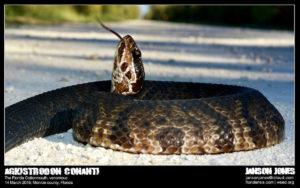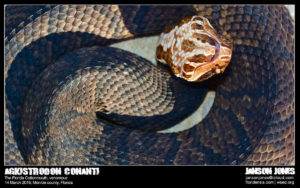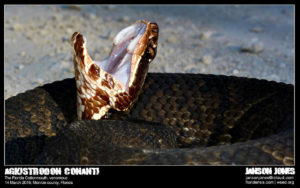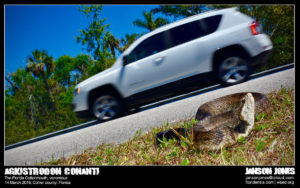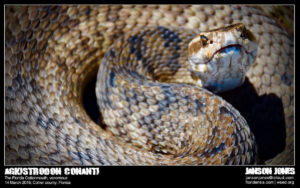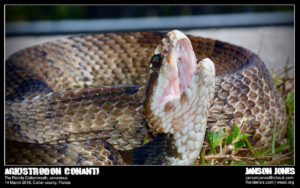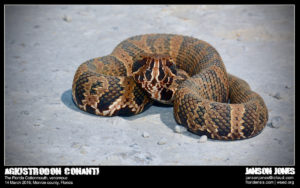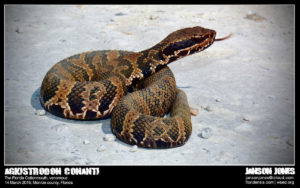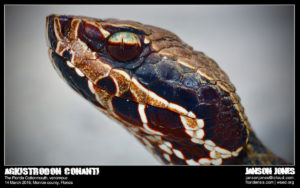The Florida cottonmouth is, of course, a venomous species whose reputation far exceeds its reality. As a child growing up beneath the tangles of Spanish moss and palm trees that adorn the Floridian peninsula, the Florida cottonmouth was the first snake I learned about as a child, and much of that “education” was riddled with folkloric horror stories and mythological representations of what I now understand to be a highly efficient, deeply rational, and fundamentally conservative species beautifully adapted to scratching out a living in otherwise harsh and difficult environments. For my first Beneath the Palms narrative editorial, a series intended to share personal observations and experiences of growing up and interacting with wild snake species in the American southeast, I can think of no better inaugural species than the much-maligned (yet-magnificent) Florida cottonmouth, Agkistrodon conanti.
In 1774, two years before the Declaration of Independence was composed in the midst of the American Revolution, William Bartram, an American naturalist and writer, sojourned throughout much of the Floridian peninsula, carefully annotating and describing his experiences for later publication. During this time, the Floridian peninsula was known as “East Florida” and was under the domain of England. Native cultures still adorned the peninsula, and much of the land (and water) remained somewhat untainted. In his narrative description, Bartram described one particular snake species of significant note: the Florida cottonmouth, also known as the Moccasin snake:
The moccasin snake is a large and horrid serpent to all appearance, and there are very terrifying stories related of him by the inhabitants of the Southern states, where they greatly abound, particularly in East Florida: that their bite is always incurable, the flesh for a considerable space about the wound rotting to the bone, which then becomes carious and a general mortification ensues, which infallibly destroys the patient; the members of the body rotting and dying by piecemeal: and that there is no remedy to prevent a lingering miserable death but by immediately cutting away the flesh to the bone, for some distance round about the wound.
Even at this time, in 1774, dramatic representations of Florida cottonmouths vastly exceeded their reality. Though venomous and worthy of great respect and caution (double-so in a time well before antivenin), emotion still outweighs reason and logic when it comes to the cottonmouth and the risk of its venom.
Bartram later noted, however, that “I never could find any that knew an instance of any person’s losing their life from the bite of them, only by hearsay. Yet I am convinced it is highly prudent for every person to be on their guard against them.” While most sober, rational people should agree with Bartram’s cautionary attitude towards cottonmouths, it’s worth remembering that in all his travels across the region, Bartram never came across a single first-hand account of death-by-cottonmouth. As it often is today on the wiki-wiki-wild-wild-web, hearsay ruled the day.
A little over a hundred years later, another American naturalist writer, Bradford Torrey of Massachusetts, endeavored on his own sojourn through the tangles of Florida. By this time, Florida was now a bona fide state of the American union, but it was still a peninsula largely shrouded in mystery and wilderness. In one notable passage, Torrey described his own encounter with a Florida cottonmouth while hunting for purple gallinules on the St. Johns River with a young local guide:
[A]s the boat was grazing the reeds, I espied just ahead a snake lying in wait among them. I gave the alarm, and the boy looked round. “Yes,” he said, “a big one, a moccasin,-a cotton-mouth; but I’ll fix him.” He pulled a stroke or two nearer, then lifted his oar and brought it down splash; but the reeds broke the blow, and the moccasin slipped into the water, apparently unharmed. That was a case for powder and shot. Florida people have a poor opinion of a man who meets a venomous snake, no matter where, without doing his best to kill it. How strong the feeling is my boatman gave me proof within ten minutes after his failure with the cotton-mouth. He had pulled out into the middle of the river, when I noticed a beautiful snake, short and rather stout, lying coiled on the water. Whether it was an optical illusion I cannot say, but it seemed to me that the creature lay entirely above the surface,-as if it had been an inflated skin rather than a live snake. We passed close by it, but it made no offer to move, only darting out its tongue as the boat slipped past. I spoke to the boy, who at once ceased rowing.
“I think I must go back and kill that fellow,” he said.
“Why so?” I asked, with surprise, for I had looked upon it simply as a curiosity.
“Oh, I don’t like to see it live. It’s the poisonousest snake there is.”
This is the attitude I largely grew up with in Florida a hundred years after Torrey’s own little encounter. My childhood was marked by locals and non-locals alike shaking their fists with the mindset of “The only good snake is a dead snake” — especially when it came to the Florida cottonmouth. They’re aggressive, I was told. They’ll chase you, they said. They’re vengeful, the Good People of Florida warned my younger self again and again. If I’ve learned anything thus far in life, however, it’s that experience is a far better teacher than most people. If you want to really learn about the world around you, experience can be a sober, objective instructor — but only if you attune yourself to listen, watch, and observe carefully.
In my life, I’ve “worked” with countless Florida cottonmouths (by “work” I mean photograph and observe). To date, I have yet to come across an aggressive cottonmouth, and though I’ve unintentionally given a few cottonmouths reason to be pissed at me, I have yet to find a Florida cottonmouth to hold a grudge (I can’t say the same for people). In reality, I find Florida cottonmouths to be confident and assertive, yes, but far more defensive than aggressive. Most will steadily slink away into the water or beneath the cover of foliage. More than a few will instead choose to hold their ground, coiling up and sometimes flashing their white-cottony mouths as a defensive, threatening posture. Twice I’ve had Florida cottonmouths move in my immediate direction, but in both cases I was simply standing between the snake and its preferred aquatic retreat; I simply stepped out of the way, and all was well. To date, I have not yet been in a knife fight with an aggressive, deranged Florida cottonmouth.
I often like to describe snakes as being highly efficient, highly rational organisms. Energy is the main currency of their lives, and as cold blooded reptiles that currency is precious. In short, snakes tend to be rather efficient and conservative in how they choose to spend that currency. They don’t tend to burn excess amounts of energy unless there’s something to gain from it. Unlike some people, Florida cottonmouths understand very well that they are unable to eat people. Thus, chasing people and biting them doesn’t really compute — logically, from the snake’s perspective. A cottonmouth has nothing to gain from such an expenditure of energy; it’s a waste of energy. It simply costs less to slink into the water or, even better, to assume a stationary posture of warning.
Whether big or small, young or old, Florida cottonmouths truly are rational, steady creatures. If you learn to keep an eye out for them, and if you learn to not panic when you do see them, they can serve as exemplars of conservative and efficient biological adaptation. Intent, steady, and focused, Florida cottonmouths simply don’t exhibit the folkloric descriptions of deranged vengeance and aggression more commonly seen in their human counterparts.
To wrap up, the three Florida cottonmouths you see featured throughout this post were each photographed on the same day in south Florida — one young adult, one elder adult, and one little kid just getting started in this game called Life. All three cottonmouths were quite reserved and protective of themselves, and not one of them acted aggressively or erratically. Three reminders on the same day of just how rational, calm, and collected Florida cottonmouths typically are.
Janson Jones, 05 Nov. 2018
http://floridensis.com
